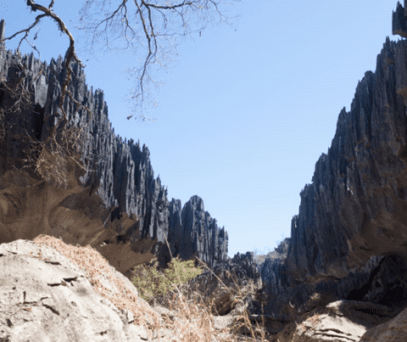
Tsingy de Namoroka
On the plan
Area 22 227 ha
VISIT US
Depending on your means of transport :
- Ground Transportation
Travel by cart from Soalala to Vilanandro during the rainy season from January to April.
- Maritime transport
- First by speedboat/boat from Mahajanga to the village of Katsepy (approx. 1h journey), then by 4x4 car from this village to the town of Soalala (approx. 7h journey in dry season), where there is the Madagascar National Parks reception office.
- Soalala to Port Aquamas (approx. 500m) by motorboat / pyrogue / ferry, then by 4X4 car / motorcycle to Vilanandro (approx. 60km).
- By motorcycle direct from the village of Katsepy to Soalala (approx. 160km), then cross the sea from Soalala to Port Aquamas, take the motorcycle to Vilanandro (approx. 60km).
- Air transport
None
Ideal period
The ideal time to visit Tsingy de Namoroka National Park is the dry season from May to November.
Available activities
- In Namoroka, hiking opportunities to see the Tsingy, wildlife observation.
- Visits are always guided either by Park Agents or CLP trackers.
- Camping: in the village of Analatelo, or at vilanandro.
Reception infrastructures
- Mise en place d’un poste de garde prévu cette année 2025 à Andranambokely (FKT Vilanandro).
- Les Touristes après avoir passé au bureau du MNP à Soalala seront reçus dans le village d’Ambatofolaka par les Agents MNP ou des CLP.
- Pour les autres infrastructures : aires de camping, des panneaux d’indications, aire de restauration, points de contrôle, …. des missions de prospections des sites seront prévues pour cette année 2025
Fees and charges
Download the reference document to find out more about park fees and charges.
Advisory equipment
We recommend that you wear suitable footwear for travel over rocks and theTsingy,
- light clothing,
- mosquito repellent and/or insect repellent.
Code of conduct
All ecotourism visitors must be accompanied by Madagascar National Parks Park Agents or CLP trackers.
The circuits
| Tours | Summary | Difficulty | Duration | Tour plans |
|---|---|---|---|---|
| « Petit Tsingy » à Antsifotra | Observation of Tsingy, aquatic birds (freshwater), caves, bats (in caves), lemurs. | |||
| « Lac Bleu » à Mandevy | Lemurs, Crocodiles (rare). | |||
| « Grand Tsingy » A ambovonomby | Cave, Tsingy, Lemurs |





